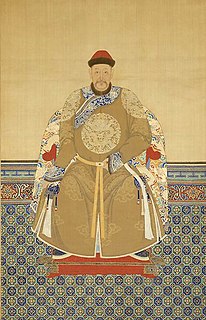Baindari (Manchu: ![]()
Manchu is a critically endangered Tungusic language spoken in Manchuria; it was the native language of the Manchus and one of the official languages of the Qing dynasty (1636–1911) of China and in Inner Asia. Most Manchus now speak Mandarin Chinese. According to data from UNESCO, there are 10 native speakers of Manchu out of a total of nearly 10 million ethnic Manchus. Now, several thousand can speak Manchu as a second language through governmental primary education or free classes for adults in classrooms or online.

Traditional Chinese characters are Chinese characters in any character set that does not contain newly created characters or character substitutions performed after 1946. They are most commonly the characters in the standardized character sets of Taiwan, of Hong Kong and Macau, and in the Kangxi Dictionary. The modern shapes of traditional Chinese characters first appeared with the emergence of the clerical script during the Han Dynasty, and have been more or less stable since the 5th century.
Hanyu Pinyin, often abbreviated to pinyin, is the official romanization system for Standard Chinese in mainland China and to some extent in Taiwan. It is often used to teach Standard Mandarin Chinese, which is normally written using Chinese characters. The system includes four diacritics denoting tones. Pinyin without tone marks is used to spell Chinese names and words in languages written with the Latin alphabet, and also in certain computer input methods to enter Chinese characters.
He was a member of the Nara clan although his ancestors were originally members of the Ikderi clan and belonged originally to the Nimaca tribe on the banks of the Amur river. Migrating southward, they put themselves under the protection of some Nara clansmen. Then, after slaying seven oxen in a sacrifice to Heaven, they exchanged their own name for that of their protectors. Six generations later, his grandfather Wangginu, consolidated his position by establishing a settlement at Mount Hūrki on the Huifa river, where the natural advantages of his location enabled him to withstand repeated attacks from the Mongols.
On the death of his grandfather Wangginu, who was beile of the Hoifa, Baindari murdered seven uncles who might have stood in his way and proclaimed himself beile of the Hoifa. In 1593, he joined the Hoifa with the tribes of Yehe, Hada, Ula, Khorchin, Sibe, Guwalca, Jušeri, and Neyen against Nurhaci. This alliance led by Narimbulu of the Yehe would prove unsuccessful as Nurhaci defeated the allied tribes at the Battle of Gure. In 1595, Nurhaci retaliated by killing two of Baindari's generals and taking the town of Dobi. In 1597 the Hūlun tribes agreed on a truce with Nurhaci and thereafter Baindari, whose territory was situated between the Yehe towns and Nurhaci's center of operations, wavered in allegiance from one to the other, finally deciding to trust in the impregnability of his city to defend him against both. In 1607, however, Nurhaci invaded the region, killed Baindari and his son, and thus conquered the Hoifa tribe.

Nurhaci was a Jurchen chieftain who rose to prominence in the late 16th century in Manchuria. Nurhaci was part of the Aisin Gioro clan, and reigned from 1616 to his death in September 1626.
Hūlun was a powerful alliance of Jurchen tribes in the late 16th century, based primarily in what is today Jilin province of China.
Baindari Born: ? Died: 1607 | ||
| Regnal titles | ||
|---|---|---|
| Preceded by Wangginu | Beile of the Hoifa ?-1607 | Succeeded by extinct |








